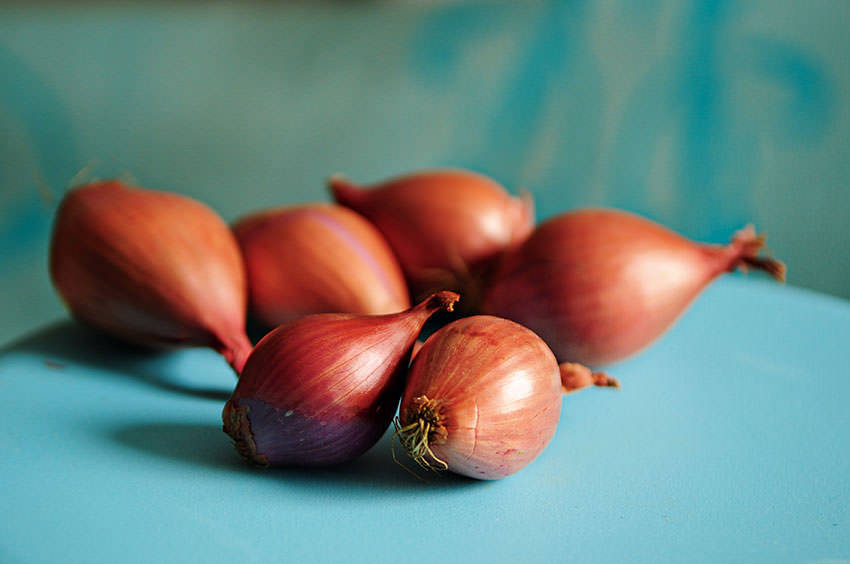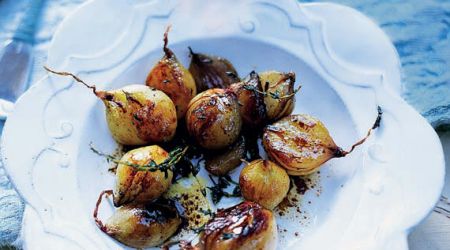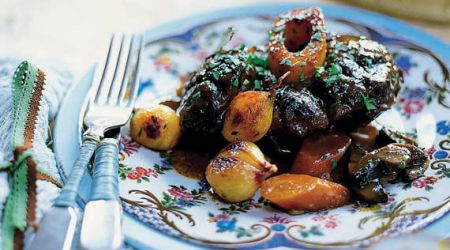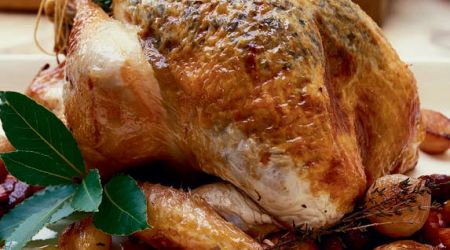Shallots
Diminutive in size but big in flavour, Clarissa Hyman charts haute cuisine’s love affair with that delicious spring bulb, the shallot with recipes by Linda Tubby
Small but perfectly formed, shallots are miniature members of the allium family, and probably the most highly prized of the tribe amongst cooks.
If onions are an everyday necessity, then shallots are a refined culinary pleasure. Their alternative name, scallion, is connected to Ascalon, a Crusader city in Palestine, although it is now believed the little onion originated much further east in Central Asia. According to the estimable Dr Johnson, the Vulgar Latin name of iscalonia evolved via Old French to echalotte, eschalot and eventually to shallot in 18th-century English, the word we use today. Shallots are particularly associated with the classic cuisine and claret of Bordeaux – no self-respecting sauce bordelaise, for example, dare be without its shallots. Their use spread northwards throughout France, until they were adopted by Parisian cuisine. Shallots are still more widely used and accorded higher status in French regional and haute cuisine than in their British counterparts. This is a pity because they are sweeter, more subtle and delicate, yet at the same time more intense than the onion. Less watery, they have a fullbodied but mellow flavour that is the essence of onion without the acrid smell. And, like garlic, a little goes a long way. Varieties include round, copper-brown shallots with yellow flesh that divides into fat cloves and tastes quite similar to onions; grey shallots, with a small, round bulb and a clear, fine flavour, sometimes called the ‘epicure’s choice’; pink shallots with a stronger flavour and crisp texture; and torpedo-style banana shallots with a large, single elongated bulb, pale brown papery skin and superior, sweet and mild taste. Finely chopped raw shallots can be added to salads and crudités, vinegars and dressings, or to grilled fish and fried meat.
They should be used with discretion, but a piquant tablespoon can transform a simple green salad. Finely chopped and pounded, they flavour classic sauces such as Béarnaise and savoury butters. When chopped and cooked they melt down to a purée that forms the basis of many dishes and sauces such as duxelles, a mixture of sautéed mushrooms and shallots; mirepoix, a diced carrot, celery and shallot bed for braised meats; or beurre blanc, white butter sauce for white fish. Shallots can make the basis of a delicious savoury version of tarte tatin, and they add flavour and texture when slow-cooked whole in casseroles and stews. Peeled and caramelised or roasted whole in their skins, they add a wonderful sweetness to roast beef or lamb. Or chop them finely to serve with blinis and smoked salmon or with sour cream and caviar to accentuate the subtle flavours they accompany.
And, there is little better condiment for oysters on the shell than chopped shallots added to red wine vinegar, salt and pepper. Shallots are usually associated with French cooking, but small red Thai shallots, with their strong but sweet flavour, are also widely used in South-East Asian cuisine. They can be sliced and deepfried, used as a garnish for salads and rice dishes, or pounded with lemongrass, chillies, galangal or coriander for curries, stir-fries and spice pastes. Easy to grow, they are a good kitchen-garden starter when planted in a sunny, weed-free bed. Traditionally started from sets (immature onion bulbs), they can now be grown from hybrid seeds. Planted on the shortest day of the year, they grow and divide rapidly, and the clusters of bulbs are useful for small-scale cookery. Shallots should look like plump, solid bulbs with tight skin and, as with onions, any that are soft, mouldy or have started to sprout should be discarded. Once harvested, shallots keep very well if stored in a cool, airy place away from the light (not the fridge).
If left in the light for too long they’ll soften and collapse, begin to sprout and loose their pungency. Small round shallots will keep a month or two, longer than banana shallots which will only last up to about two weeks, although it may depend on the amount of moisture in the bulb – the dryer and harder it is, the longer it will keep. Pickling is an excellent way of keeping shallots. First they need to be peeled: to make this easier, blanch in boiling water for a minute to loosen the skin, then drain and run under cold water. Once achieved, simply fill a jar, add a variety of spices – yellow mustard seeds, peppercorns, coriander seeds, allspice and chilli peppers, bay leaves, cloves, mace and ginger – and cover with malt vinegar. Seal and leave for several months. No need for salt or sugar, they are sweet enough. Alternatively, simply pickle them with cloves of garlic in balsamic vinegar.
And, before you ask, Tennyson’s ‘Lady of Shallot’, was not abandoned because she was an avid onion lover. Well, she may or may not have been, but she got her name because she actually came from a place called Scalot.

Recipes
Get Premium access to all the latest content online
Subscribe and view full print editions online... Subscribe



